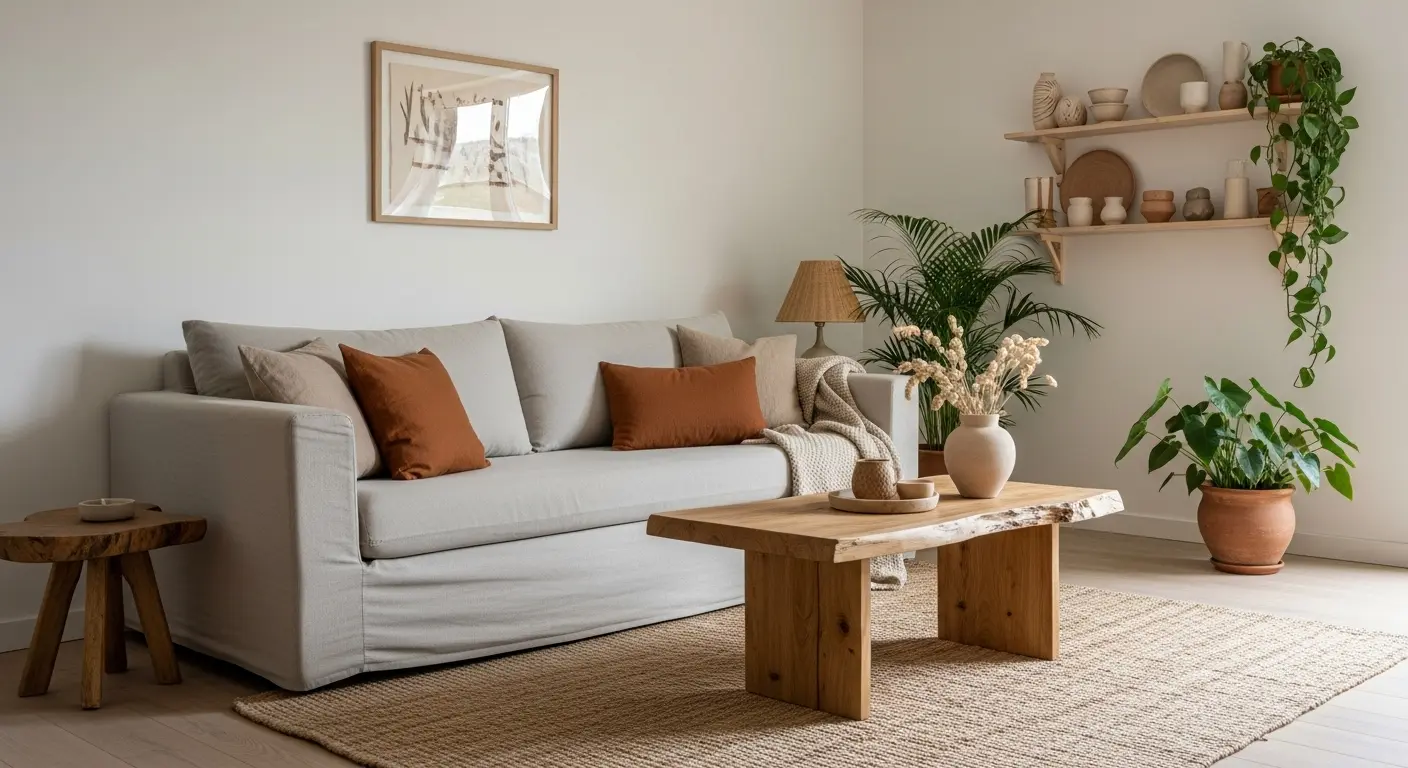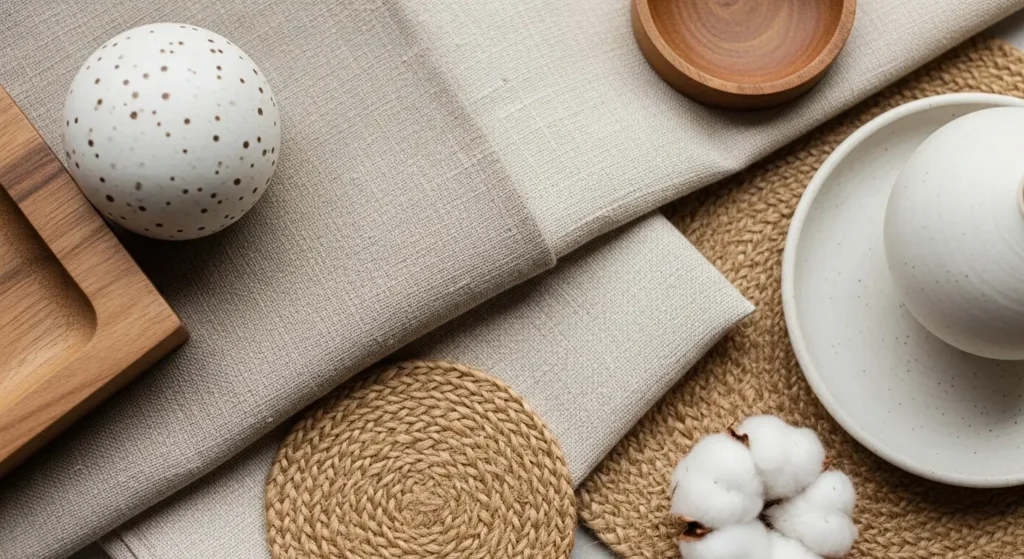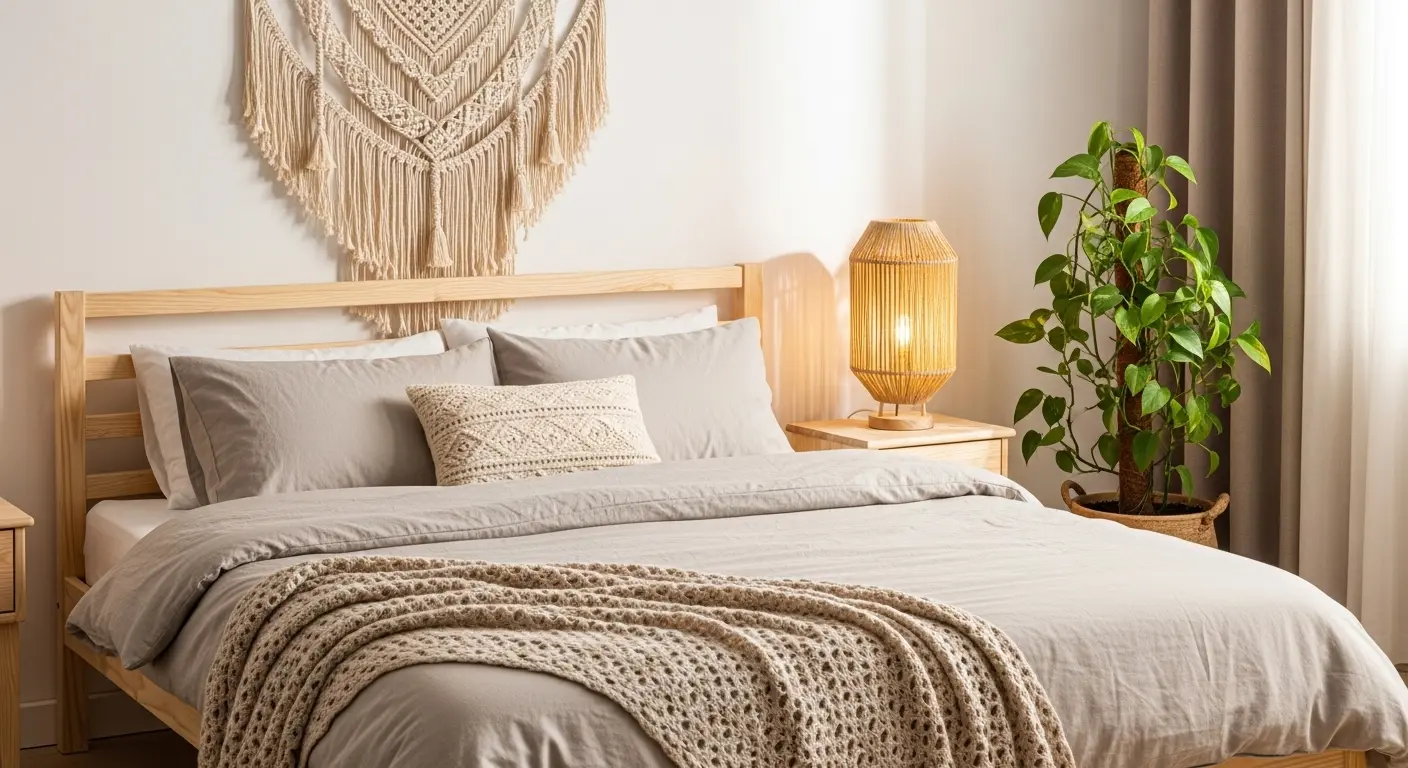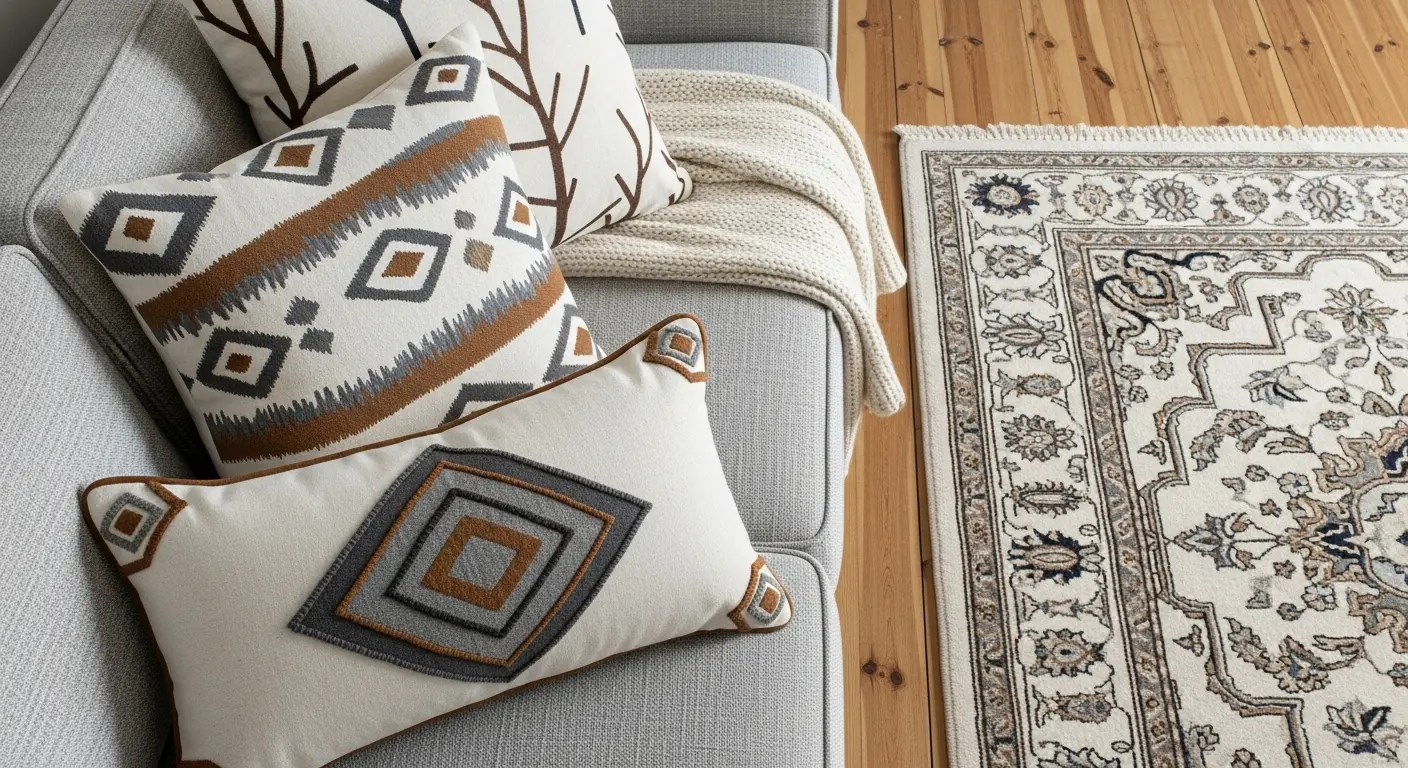
Did you know it’s possible to combine the simplicity of minimalism with the vibrant soul of bohemian style? Minimalist Boho is proof that functionality and artisanal expression can coexist in perfect harmony. More than just a style, it’s a philosophy that transforms spaces into light havens, full of texture, affection, and personality.
In this article, discover how to adapt the boho aesthetic to minimalism, creating elegant, authentic, and welcoming environments—even in smaller spaces.
What is Minimalist Boho?
The Fusion of Clean Contemporary and Bohemian Spirit
Imagine a space where the essential meets the affective, where every object has a function but also tells a story. Minimalist Boho is born from this union: on one side, minimalism with its clean lines, neutral palette, and pursuit of simplicity; on the other, the bohemian style, full of textures, soft colors, natural elements, and handmade pieces.
This encounter creates environments that are both serene and welcoming, allowing the home to be an authentic reflection of the inhabitant’s personality—but without the weight of excess.
The Aesthetic of the Essential with an Artisanal Soul
Unlike traditional boho, which often relies on accumulating objects, minimalist boho values conscious curation: fewer pieces, but with more meaning. The space gains texture through natural rugs, crochet throws, handmade ceramics, while colors remain soft and the distribution of elements favors emptiness and lightness.
Here, the focus is not on filling, but on filling with intention. Creating environments that breathe and, at the same time, embrace.
The result? A home with a contemporary aesthetic, but full of soul and human warmth—a space where modern functionality and the free bohemian spirit balance uniquely.
Key Elements of Minimalist Boho

Handmade Pieces with Purpose
In Minimalist Boho, every object is chosen with intention. Handmade pieces are protagonists, not just for their aesthetics, but for the history and affection they carry. These include carved wooden furniture, handmade tapestries, and ceramics molded with imperfections that reveal the human touch. These elements create an environment that speaks, inviting contemplation and touch.
Unlike the excess of traditional boho, here the handmade appears punctually and strategically, standing out against a clean and neutral base.
Natural Fabrics and Light Textures
Texture is the common thread that brings minimalist boho to life. Natural fabrics like linen, raw cotton, jute, and macramé add a sensory layer to the space without being visually heavy. They soften the rigidity of minimalist lines and offer an invitation to comfort.
How to include these textures lightly:
- Linen pillows and crochet throws on neutral sofas
- Natural fiber rugs defining areas
- Flowing cotton curtains that allow light to pass through
- Macramé panels or baskets as affective focal points
Organic and Sustainable Materials
Minimalist boho is also a style deeply connected with nature. Therefore, organic and sustainable materials are essential: solid wood, bamboo, clay, aged iron. These are raw materials that not only decorate but also reinforce the commitment to more conscious and durable consumption.
Tip: Prioritize local and handmade pieces that carry identity and respect the environment—adding emotional and aesthetic value to the environment.
When composing your minimalist boho space, remember: the focus is on authenticity, not quantity. Each element should have a function or a story, creating an atmosphere that welcomes, inspires, and reflects who you are.
How to Apply Minimalist Boho in Different Environments
Living Room: Personality and Serenity in the Heart of the Home
The living room is the perfect space to express the essence of minimalist boho: welcoming, functional, and full of soul. Here, less is more—but with texture and affection.
How to apply:
- A sofa in linen or raw cotton, complemented by pillows in earthy tones or with discreet ethnic prints.
- A jute or sisal rug, defining the area without being visually heavy.
- Open shelves or niches with affective objects: a handmade ceramic piece, an old book, a plant in a clay pot.
The secret lies in keeping the space fluid, with elements that invite rest but also contemplation.
Bedrooms: Bohemian Coziness with Minimalist Lightness

The minimalist boho bedroom is a personal refuge, where soft textures and handmade elements create a welcoming and relaxing environment without losing lightness.
Key elements:
- Bed with a headboard in natural wood or aged iron.
- Throws or bedspreads in crochet or linen, layered casually.
- Soft lighting, with lamps made of natural fibers or lampshades with fabric covers.
- A macramé panel or a delicate tapestry as a focal point.
Avoid excessive furniture: opt for one or two pieces that combine aesthetics and functionality.
Kitchens and Balconies: Spaces Full of Life, but Without Excess
In the kitchen, minimalist boho manifests through visible but organized utensils and natural materials that warm the space.
In the kitchen:
- Shelves with rustic ceramics, straw baskets, and glass jars.
- Countertops in wood or stone, without many ornaments, but highlighting the essential.
On the balcony or porch:
- Wicker or bamboo chairs or benches, with neutral cushions.
- Various plants in clay or raw cement pots.
- An outdoor rug in natural fiber to define the space.
Even if small, these environments can become true natural and bohemian refuges, perfect for relaxing or receiving friends with charm and simplicity.
Colors and Patterns in Minimalist Boho

The Balance Between Neutral Palette and Bohemian Touches
In minimalist boho, the color palette is carefully balanced to maintain lightness and avoid excess. The background is predominantly neutral—shades of beige, sand, off-white, and light gray—creating a calm and clean base, characteristic of minimalism.
Against this base, bohemian touches are introduced: warm, earthy, and natural colors that add coziness and personality, but always in moderation.
To further explore how colors can transform a space without compromising lightness, check out our article on How to Use Colors to Create Minimalist and Cozy Environments, with inspiring and applicable suggestions. [Note: The original link points to ‘#’, keep it or replace if a valid URL is known]
Earthy Tones: The Link Between Natural and Handmade
Traditional boho is known for its chromatic richness, but in the minimalist context, these colors are filtered and softened.
Colors that work well:
- Terracotta, clay, caramel
- Olive green, moss, sage
- Soft mustard, discreet rust
These tones can appear in pillows, throws, rugs, or small decorative objects—always with the intention of warming the space without overwhelming it.
Patterns: Discreet, Ethnic, and Well-Positioned
Boho patterns are known for their ethnic and geometric designs, but in minimalist boho, they should be used sparingly, functioning almost as visual accents.
How to include patterns without losing lightness:
- Rugs with geometric patterns in neutral or earthy tones.
- Pillows with discreet ethnic motifs.
- Paintings or tapestries with simple graphics.
The idea is that the pattern brings visual interest and identity to the space, but without compromising the feeling of spaciousness and serenity.
Essential Tip:
Whenever you include a pattern, balance it with areas of visual rest—plain walls, furniture with simple lines, and neutral fabrics. This way, the space maintains its minimalist aesthetic, with an irresistible boho touch.
Common Mistakes When Combining Minimalism and Boho—And How to Avoid Them
The Danger of Excess Textures and Colors
One of the most frequent mistakes when trying to unite minimalism and boho is falling into the temptation of accumulating too many textures, colors, and objects. Boho, by nature, is exuberant; but in the minimalist context, it is necessary to filter and select.
How to avoid:
- Choose few standout elements: a textured rug, a handmade throw, a few pillows with discreet patterns.
- Maintain a neutral base: walls, sofas, and larger furniture should follow the minimalist line.
- Prioritize quality over quantity: invest in well-made pieces with meaning, instead of accumulating cheap or purposeless items.
Lack of Visual Unity: The Risk of Disconnection
Another common mistake is mixing boho and minimalist elements without creating a visual connection between them. The result can be a fragmented environment, where the styles seem to compete rather than complement each other.
How to ensure unity:
- Maintain a cohesive color palette, even when adding earthy tones or patterns.
- Repeat materials or textures in different parts of the room (e.g., light wood on the sofa and a shelf).
- Use lighting to unify the space, creating a soft and continuous atmosphere.
Ignoring Functionality for Aesthetics
Minimalism values functionality, while boho values expression. In minimalist boho, finding the balance is crucial: each piece should be beautiful, but also useful.
How to balance:
- Before adding a decorative object, ask yourself: does it have any practical function or special meaning?
- Avoid purely aesthetic furniture that takes up space without adding utility.
- Organize elements to facilitate circulation and use of space.
Remember: minimalist boho is not about creating a backdrop, but a functional, welcoming, and authentic home.
Conclusion: Minimalist Boho — A Conscious and Affective Lifestyle
Minimalist Boho is more than a decoration trend; it is an invitation to live with more intention, beauty, and connection. By uniting the functional simplicity of minimalism with the warm, artisanal soul of boho, you create spaces that not only please the eye but also nurture well-being.
Remember the pillars:
- Neutral and clean base
- Natural and handmade textures
- Earthy and soft colors
- Pieces with purpose and meaning
- Balance between functionality and aesthetics
By applying these principles, you transform your home into an authentic refuge, where every detail reflects your personality and your conscious lifestyle.
How about starting to experiment? Choose a corner of your home, add a handmade piece you love, a textured throw, or a plant in a clay pot. Small gestures can initiate a great transformation.
If you identified with this fusion of styles and want to continue exploring how to create environments with more meaning, also check out our guide on How to Create a Cozy Minimalist Environment: Tips and Inspirations. In it, you will find even more ideas to make your home a space of serenity and beauty. [Note: The original link points to ‘#’, keep it or replace if a valid URL is known]
